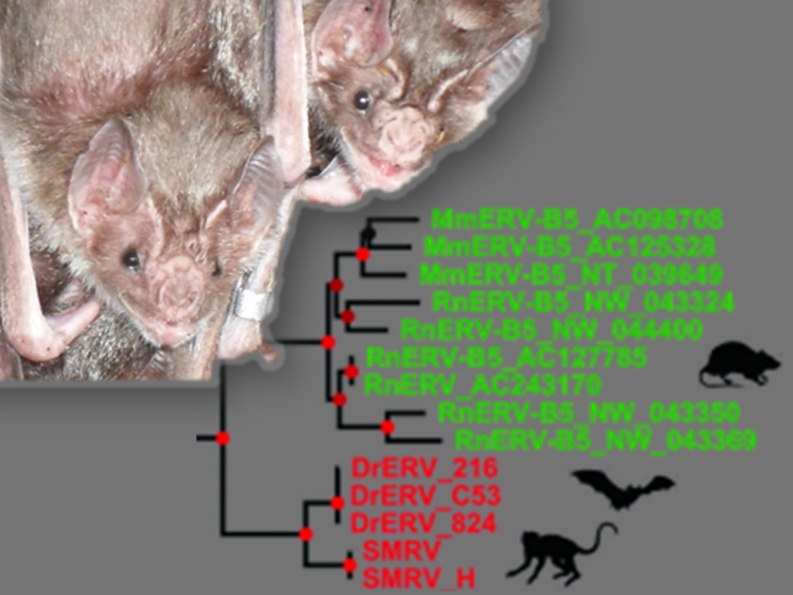Scientists discovered a new retrovirus “fossil” found in the common vampire bat which is homologous to retroviruses in rodents and primates. The results suggest the recent circulation of an active infectious retrovirus and cross-species transmission. The study has been published in the scientific journal “Journal of Virology”.
Vampire bat (Desmodus rotundus) samples from Mexico and from the Berlin Zoological Garden revealed a new endogenous retrovirus (named DrERV after Desmodus rotundus endogenous retrovirus) that is also present in rodents and primates but is absent in other closely related bat species. The results suggest that this virus historically jumped more than once among different species. Moreover, evolutionary analysis showed that this virus integrated long ago in vampire bats but very recently in monkeys and rats, suggesting that an active infectious counterpart of DrERV might still be in circulation.
“We were surprised to get a result that suggests that vampire bats may not be the reservoir for this retrovirus but might have been infected independently of monkeys and rats by a yet undiscovered reservoir”, says Marina Escalera, leading author of the study.
A large international team of scientists decided to search for viruses other than rabies present in the vampire bat. Members of the team are the Department of Wildlife Diseases research of the German Leibniz Institute for Zoo and Wildlife Research in Berlin (IZW) headed by Alex Greenwood, the National Autonomous University of Mexico (UNAM) and the National Center for Research in Animal Microbiology (CENID-INIFAP) among other institutions in Mexico and the Centre for Geogenetics of the Natural History Museum of Denmark. The scientists first reported find was a special kind of ‘fossil’ virus, called an endogenous retrovirus (ERV). ERVs belong to the same family as the HIV virus, but unlike HIV, they are viruses that circulated in the past and that were able to integrate themselves into the genomes of their hosts. Therefore, they provide a window into studying past viral infections that happened over millions of years in different species. Nonetheless, some ERVs may still retain the ability to become reactivated and are implicated in the development of diseases.
“An important focus of our group is to study novel and historical pathogen transmission among wildlife and its evolutionary implications. We have studied the evolution of retroviruses in several mammalian species, and as retroviruses are primarily transmitted via blood to blood contact, we hypothesised that the vampire bat could carry retroviruses that were particularly prone to jumping from one species to another throughout their evolutionary history”, explains Greenwood.
Pathogen surveillance in wildlife is an important strategy for detecting viruses that could represent a health risk to both humans and other animals. The common vampire bat is widely distributed in Latin America, from Southern Mexico to Northern Chile, Brazil and Uruguay and often feeds on blood from domestic animals, such as cattle. Vampire bats are known to carry the rabies virus but little is known about other viruses that they might carry.
This study represents the only research done so far on endogenous retroviruses of New World bats and suggests there is still much to be learned about vampire bats as viral reservoirs.
Publication:
Escalera-Zamudio M, Mendoza MLZ, Heeger F, Loza-Rubio E, Rojas-Anaya E, Méndez-Ojeda ML, Taboad B, Mazzoni CJ, Arias CF, Greenwood AD (2015):
A novel endogenous betaretrovirus in the common vampire bat (Desmodus rotundus) suggests multiple independent infection and cross-species transmission events. J VIROL. Doi: 10.1128/JVI.03452-14.
http://jvi.asm.org/content/early/2015/02/19/JVI.03452-14.abstract
Contact:
| Leibniz Institute for Zoo and Wildlife Research (IZW) in the Forschungsverbund Berlin e.V. Alfred-Kowalke-Str. 17 10315 Berlin www.izw-berlin.de Marina Escalera, +49 30 5168 232, escaleraizw-berlin.de Prof Alex D Greenwood PhD, +49 30 5168 255, greenwoodizw-berlin.de Steven Seet, +49 30 5168 125, seetizw-berlin.de |


